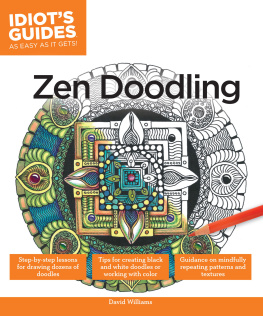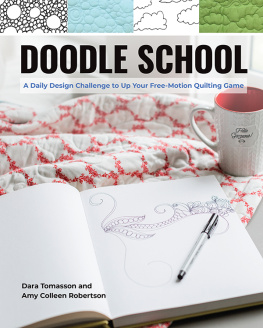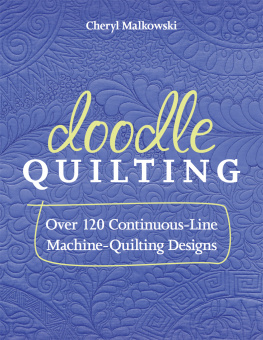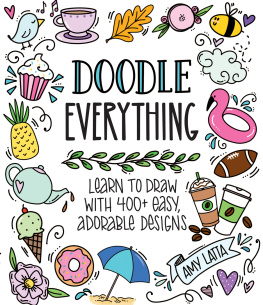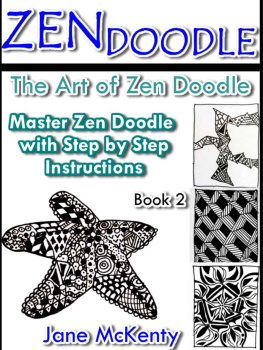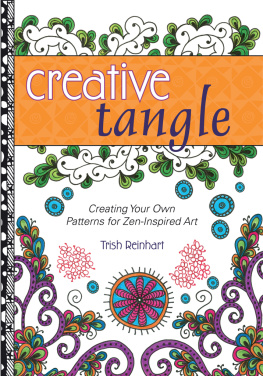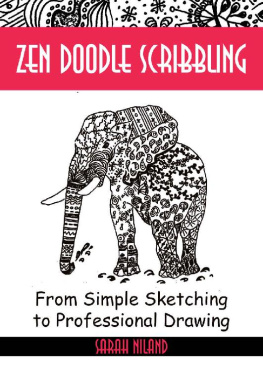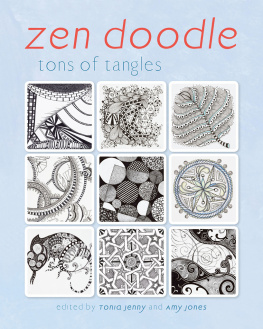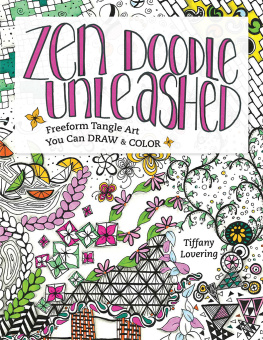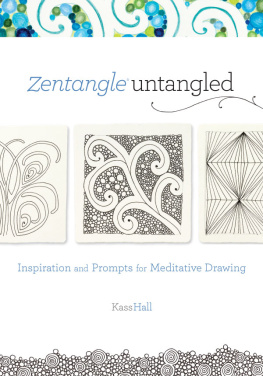Zen Doodling
by David Williams
A member of Penguin Group (USA) Inc.
Publisher: Mike Sanders
Executive Managing Editor: Billy Fields
Executive Acquisitions Editor: Lori Cates Hand
Development Editorial Supervisor: Christy Wagner
Senior Designer: Rebecca Batchelor
Production Editor: Jana M. Stefanciosa
Indexer: Heather McNeill
Layout Technician: Brian Massey
Proofreader: Cate Schwenk
PRODUCTION, LONDON
Digital Producer: Alex Valizadeh
Senior Digital Producer: Miguel Cunha
DIGITAL OPERATIONS, DELHI
Head of Digital Operations: Manjari Hooda
Producer: Rahul Kumar
Assistant Editor: Etika Kapil
DTP Designer: Manish Bhatt
Operations Assistant: Tauhid Nasir
For John and Audrey, who are in every page.
Introduction
Doodles are informal drawings, but the array of styles and correlations is wide. Some are intricate and labored; some consist of shaded textures; some contain patterns; others include recognizable figurative elements. Zen doodling, which originates neither in Zen Buddhism nor in the informality of most doodling done in general, borrows from all these things and refines them into a captivating, contemplative form of drawing. Zen doodling is fairly easy to learn, even for the novice, and its fun.
A Zen doodle is made mostly by repeating patterns, ranging from simple to complex, each with a distinctive texture and tonal quality that adds to the overall effect. Sometimes the goal of attaining a mindful state is linked to the process of its creation, which accounts for the Zen part of the name. Traditionally, with Zen, you aspire to higher mental focus by emptying your mind of daily concerns through meditation. The Zentangle method is a kind of Zen doodling that engages this aspect of mindfulness along with special pattern units, called tangles, and by beginning with a spontaneous penciled line called a string. Zen doodling may resemble that process, but it includes an even more eclectic range of patterns, methods, and results.
This book presents some possibilities of what a Zen doodle can be. I illustrate the basic aspects of the art form and the underlying design principles as well as strategies for creativity. I give you some common building blocks, explore using tone and color, and present the various ways to create a Zen doodle in simple, step-by-step lessons, with examples ranging from easy to more difficult. As you travel through the pages of this book, build your understanding of the various methods by following the instructions, but also challenge yourself to create your own doodles based on what you learn here. Zen doodles are full of twists, turns, and complications, and each one is unique. Start one and follow it all the way to completion. When you reach a critical point, you might be tempted to give up, but dont. Instead, take a break and come back to it later to see where you want to go next. Each Zen doodle is a journey to surprising and sometimes curious designs. I give you a foundation in these pages; only you know where your creativity might take you.
An important aspect of this kind of drawing is the pace at which you make the lines. Begin drawing slowly to get a feel for the shapes and the speed required to make them. If you draw slowly enough that your lines possess a wavering quality, speed up a little to smooth them out. Avoid using a ruler to draw straight lines; ruled lines stand out in a distracting way in a mostly hand-drawn image, while the unpredictable nature of freehand lines adds energy and life to a drawing. In areas that require more exactness, such as circles and complex patterns based on grids, lightly pencil in the shape contours or the vertical and horizontal structure first and erase them later if theyre still visible.
If you make mistakes as you doodle, build them into your drawings. Camouflage a stray mark by surrounding it with similar marks that transition into something else. Or alter goofs into something less conspicuous with a few well-placed accents. If youre not sure what to do with mistakes, consider them from different angles to decide how to work them in. Mistakes can be the necessary impetus pushing you to see things in a new wayand ultimatelyto greater creativity.
Deeper than words, the language of the heart and soul is likely formed with color and shape. Zen doodling utilizes that language to suggest meaning with its seas of spilled-out patterns and its stretches of stippling, star shapes, and strands. Each doodle is a voyage to a far-off land with fascinating flora and fauna. At the tip of your pen, the whole exotic trip happens in mere moments. My hope is that you rekindle your creativity, one pen-powered journey at a time.
ONLINE EXTRAS
Sometimes it helps to have a head start. At idiotsguides.com/zendoodling, weve shared several of the blank contours shown throughout the book, as well as several new ones, you can download, print, and use as a starting point for your own doodles.
ACKNOWLEDGMENTS
The steps taken to write this book were sometimes set down cautiously, while others ticked by at a marathon pace. Theyve led to a soaring view that was possible only through combined effort. My family, Rachel and Seth, supplied love, patience, and pragmatism, and found the delicate balance between encouragement and steering clear. Chris, Cheryl, and Roger, as always, were a ready technical resource for all things rational, scientific, and mathematical. My students and friends were steadfast and provided great feedback and necessary fits of laughter. And Lori, Christy, and Becky, you gave me this space to fill and helped me fill it with the very best. Many thanks.
Doodling and Art
When you make a Zen doodle, your goal should not be to create a work of art. That imposing task will only produce fear. Instead, simply draw and reflect on what youre doing.
The process of drawing the repeating parts of a Zen doodle creates a rhythm that helps the critical voice inside your mind to quiet while life concerns float away. In this freed-up space, creativity begins to grow.
Freedom allows you to take risks without fear of criticism. Because your doodle isnt planned to be an edited and logical expression, the illusions can develop without the self-criticism that often accompanies creativity. The somewhat random bits and pieces are thought-provoking and inspire multiple interpretations. A Zen doodle is a balance of not only what is depicted but how its drawn.
THE FOCUSED MIND
The ritual of drawing begins before your pen ever touches the paper. You must first prepare your drawing space as well as prepare your mind.
To avoid unnecessary neck strain as you draw, angle your drawing surface, whether its a lap desk, a board leaning on a table or against a stack of books, or a drafting table, so its almost perpendicular to your line of sight. Light your drawing surface with a drafting lamp on the opposite side as your drawing hand or with some other source or other light source to produce even lighting.

